Alzheimer risk gene product Pyk2 suppresses tau phosphorylation and phenotypic effects of tauopathy
- PMID: 35501917
- PMCID: PMC9063299
- DOI: 10.1186/s13024-022-00526-y
Alzheimer risk gene product Pyk2 suppresses tau phosphorylation and phenotypic effects of tauopathy
Erratum in
-
Correction: Alzheimer risk gene product Pyk2 suppresses tau phosphorylation and phenotypic effects of tauopathy.Mol Neurodegener. 2022 Aug 30;17(1):56. doi: 10.1186/s13024-022-00557-5. Mol Neurodegener. 2022. PMID: 36038879 Free PMC article. No abstract available.
Abstract
Background: Genetic variation at the PTK2B locus encoding the protein Pyk2 influences Alzheimer's disease risk. Neurons express Pyk2 and the protein is required for Amyloid-β (Aβ) peptide driven deficits of synaptic function and memory in mouse models, but Pyk2 deletion has minimal effect on neuro-inflammation. Previous in vitro data suggested that Pyk2 activity might enhance GSK3β-dependent Tau phosphorylation and be required for tauopathy. Here, we examine the influence of Pyk2 on Tau phosphorylation and associated pathology.
Methods: The effect of Pyk2 on Tau phosphorylation was examined in cultured Hek cells through protein over-expression and in iPSC-derived human neurons through pharmacological Pyk2 inhibition. PS19 mice overexpressing the P301S mutant of human Tau were employed as an in vivo model of tauopathy. Phenotypes of PS19 mice with a targeted deletion of Pyk2 expression were compared with PS19 mice with intact Pyk2 expression. Phenotypes examined included Tau phosphorylation, Tau accumulation, synapse loss, gliosis, proteomic profiling and behavior.
Results: Over-expression experiments from Hek293T cells indicated that Pyk2 contributed to Tau phosphorylation, while iPSC-derived human neuronal cultures with endogenous protein levels supported the opposite conclusion. In vivo, multiple phenotypes of PS19 were exacerbated by Pyk2 deletion. In Pyk2-null PS19 mice, Tau phosphorylation and accumulation increased, mouse survival decreased, spatial memory was impaired and hippocampal C1q deposition increased relative to PS19 littermate controls. Proteomic profiles of Pyk2-null mouse brain revealed that several protein kinases known to interact with Tau are regulated by Pyk2. Endogenous Pyk2 suppresses LKB1 and p38 MAPK activity, validating one potential pathway contributing to increased Tau pathology.
Conclusions: The absence of Pyk2 results in greater mutant Tau-dependent phenotypes in PS19 mice, in part via increased LKB1 and MAPK activity. These data suggest that in AD, while Pyk2 activity mediates Aβ-driven deficits, Pyk2 suppresses Tau-related phenotypes.
Keywords: Alzheimer’s disease; C1q; Fronto-temporal dementia; PTK2B; Pyk2; Tauopathy.
© 2022. The Author(s).
Conflict of interest statement
None.
Figures



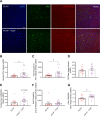

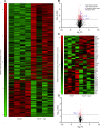

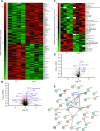
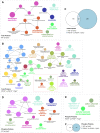
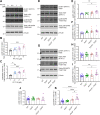
Similar articles
-
Alzheimer's Disease Risk Factor Pyk2 Mediates Amyloid-β-Induced Synaptic Dysfunction and Loss.J Neurosci. 2019 Jan 23;39(4):758-772. doi: 10.1523/JNEUROSCI.1873-18.2018. Epub 2018 Dec 5. J Neurosci. 2019. PMID: 30518596 Free PMC article.
-
Pyk2 is a Novel Tau Tyrosine Kinase that is Regulated by the Tyrosine Kinase Fyn.J Alzheimers Dis. 2018;64(1):205-221. doi: 10.3233/JAD-180054. J Alzheimers Dis. 2018. PMID: 29782321 Free PMC article.
-
Biologic TNF-α inhibitors reduce microgliosis, neuronal loss, and tau phosphorylation in a transgenic mouse model of tauopathy.J Neuroinflammation. 2021 Dec 31;18(1):312. doi: 10.1186/s12974-021-02332-7. J Neuroinflammation. 2021. PMID: 34972522 Free PMC article.
-
Microglia PTK2B/Pyk2 in the Pathogenesis of Alzheimer's Disease.Curr Alzheimer Res. 2023;20(10):692-704. doi: 10.2174/0115672050299004240129051655. Curr Alzheimer Res. 2023. PMID: 38321895 Review.
-
Role of proline-rich tyrosine kinase 2 (Pyk2) in the pathogenesis of Alzheimer's disease.Eur J Neurosci. 2022 Nov;56(9):5442-5452. doi: 10.1111/ejn.15569. Epub 2022 Jan 17. Eur J Neurosci. 2022. PMID: 34905657 Review.
Cited by
-
Exploring the Genetic Landscape of Mild Behavioral Impairment as an Early Marker of Cognitive Decline: An Updated Review Focusing on Alzheimer's Disease.Int J Mol Sci. 2024 Feb 24;25(5):2645. doi: 10.3390/ijms25052645. Int J Mol Sci. 2024. PMID: 38473892 Free PMC article. Review.
-
Targeting tau in Alzheimer's disease: from mechanisms to clinical therapy.Neural Regen Res. 2024 Jul 1;19(7):1489-1498. doi: 10.4103/1673-5374.385847. Epub 2023 Sep 22. Neural Regen Res. 2024. PMID: 38051891 Free PMC article.
-
Enhanced phagocytosis associated with multinucleated microglia via Pyk2 inhibition in an acute β-amyloid infusion model.J Neuroinflammation. 2024 Aug 6;21(1):196. doi: 10.1186/s12974-024-03192-7. J Neuroinflammation. 2024. PMID: 39107821 Free PMC article.
-
Genome-wide association study in Alzheimer's disease: a bibliometric and visualization analysis.Front Aging Neurosci. 2023 Nov 29;15:1290657. doi: 10.3389/fnagi.2023.1290657. eCollection 2023. Front Aging Neurosci. 2023. PMID: 38094504 Free PMC article.
-
Alzheimer's Disease Puzzle: Delving into Pathogenesis Hypotheses.Aging Dis. 2024 Feb 1;15(1):43-73. doi: 10.14336/AD.2023.0608. Aging Dis. 2024. PMID: 37450931 Free PMC article. Review.
References
-
- 2021 Alzheimer's disease facts and figures. Alzheimers Dement. 2021;17:327–406. - PubMed
-
- Lambert JC, Ibrahim-Verbaas CA, Harold D, Naj AC, Sims R, Bellenguez C, DeStafano AL, Bis JC, Beecham GW, Grenier-Boley B, et al. Meta-analysis of 74,046 individuals identifies 11 new susceptibility loci for Alzheimer's disease. Nat Genet. 2013;45:1452–1458. doi: 10.1038/ng.2802. - DOI - PMC - PubMed
-
- Beecham GW, Hamilton K, Naj AC, Martin ER, Huentelman M, Myers AJ, Corneveaux JJ, Hardy J, Vonsattel JP, Younkin SG, et al. Genome-wide association meta-analysis of neuropathologic features of Alzheimer's disease and related dementias. Plos Genet. 2014;10:e1004606. doi: 10.1371/journal.pgen.1004606. - DOI - PMC - PubMed
Publication types
MeSH terms
Substances
Grants and funding
LinkOut - more resources
Full Text Sources
Medical
Molecular Biology Databases
Miscellaneous

